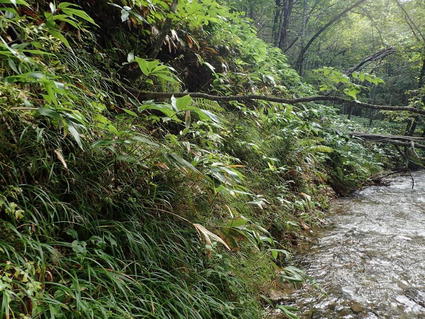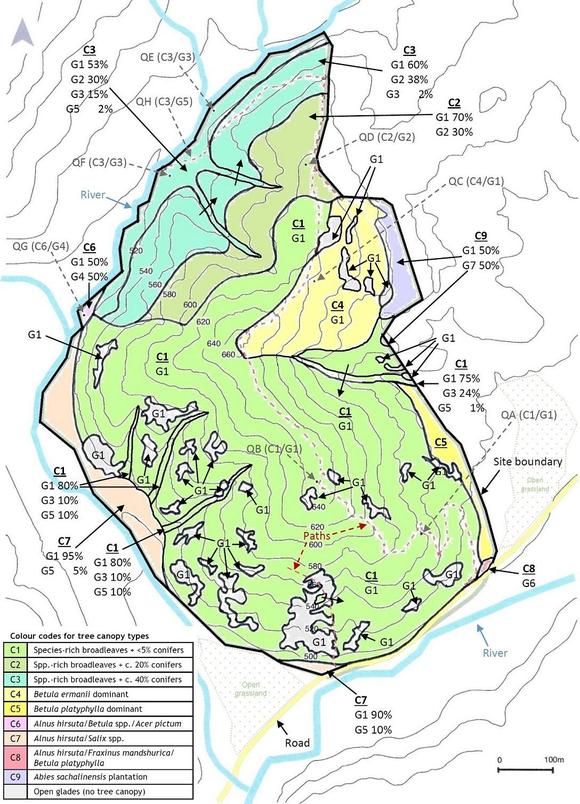Horoka Tomamu Vegetation Survey 2016 and 2018
Ground vegetation type G3 (species-rich banks) beneath canopy type C3 (mixed broadleaves + c.40% conifers) at location E, by the river at the NW edge of the site.
The Horoka Tomamu Vegetation Survey was conducted by Ben Averis, a British botanist, from 7 to 13 September 2016 and from 11 to 18 October 2018. The aim was to map and describe the plant communities, in order to gain a better understanding of the habitats and to provide a basis for future site management.
Methods
The tree/shrub canopy and the ground vegetation were classified separately. Sample quadrats were recorded in eight representative locations. At each of these locations, tree/shrub canopy species were recorded in a single 20 m x 20 m quadrat, inside which there were five smaller 2 m x 2 m ground vegetation quadrats. Additional notes were made about the vegetation types found through the site generally. Boundaries between vegetation types were mapped onto a large scale base map of the site. A list was made of all plant species found during the survey.
Results
Nine tree/shrub canopy types (C1 to C9) and seven ground vegetation types (G1 to G7) were identified. For the purpose of mapping, areas were labelled with their canopy and ground layer combinations (e.g. C4/G1). Complex small-scale mosaics of two or more ground vegetation types beneath a single canopy type are common here and were labelled with percentage estimates (e.g. C2 / G1 70% G2 30%).
In terms of individual species, a total of 161 vascular plants and 113 bryophytes (81 mosses and 32 liverworts) were recorded. Almost all of these are native to the area.
The survey confirmed the contrast between the predominantly species-poor ground vegetation, dominated by Sasa, and the species-rich tree and shrub canopy of the forest, typical of this kind of landscape in Hokkaido. Some of the steeper banks and wetter areas, especially in the north-western part of the site, have species-rich ground vegetation with interesting assemblages of herbs, grasses, sedges, ferns, mosses and liverworts.
Horoka Tomamu appears to be a good example of montane forest of this part of Japan, with the characteristic high richness in tree species, a good total number of ground flora species (even though most of the ground vegetation is species-poor because of the dominance of Sasa) and at least a moderate diversity of epiphytic bryophytes and lichens. The great abundance of dwarf bamboo is one of the main floristic differences between east Asian temperate forests and their counterparts in eastern North America; although these two regions are geographically far apart, they have broadly similar climates and share many forest plant species. Many plant species found in this survey are also native to Britain, where the climate is very different with cooler summers and much milder winters and where the species-richness of native forest tree canopies is much lower than at Horoka Tomamu.
Map
In the map above, colours are only used for tree canopy types (see key above, C1-9).
Ground vegetation types are indicated by ‘G’ codes in the labels. For areas with complex mosaics of two or more types of ground vegetation, the labels give an estimated percentage for each type present (e.g. G1 70% G2 30%).
Quadrat sampling locations are indicated by QA, QB. etc, (also indicating the C and G types found there).
The survey report itself gives full botanical details for all canopy and ground vegetation types.
Report
Ben Averis’s very detailed report is available here in pdf form. It includes further information about his methods and results, a discussion section, quadrat data, species lists, 50 photographs of habitats and species, and mapping, see full report.
Elen Averis Photo Essay
Elen Averis looks up at the autumn tree canopy, and down into the undergrowth of plants, fungi, lichens and mosses, to show the rich and developing variety of floral life in the Horoka Tomamu autumn. Here is her photo essay.
Photographs and species lists
Autumn in Hokkaido: Plants of Horoka Tomamu Montane Forest provides further information about species, ordered by broad groups of trees, shrubs, woody climbers, grasses, sedges, clubmosses, ferns, other vasculor plants, mosses, liverworts and lichens.
The lists for plants at Horoka Tomamu are also available here online, again in English and Japanese, with links to Wikipedia articles in both languages. See Species checklist (plants) and Species checklist (mosses, liverworts and lichens).
Acknowledgements
Our special thanks are due, not only to Ben Averis for his significant contribution to our knowledge about Horoka Tomamu, but also to his daughter Elen who accompanied him during the survey, and to Dr Yasuo Konno of the Obihiro University of Agriculture and Veterinary Medicine for his help with plant species identification in 2016. We are also grateful to the Shiretoko Museum in Shari for kindly inviting Ben to present a talk on British vegetation, immediately following the survey in 2016.
Simon and Masumi Holledge, 22 March 2020


